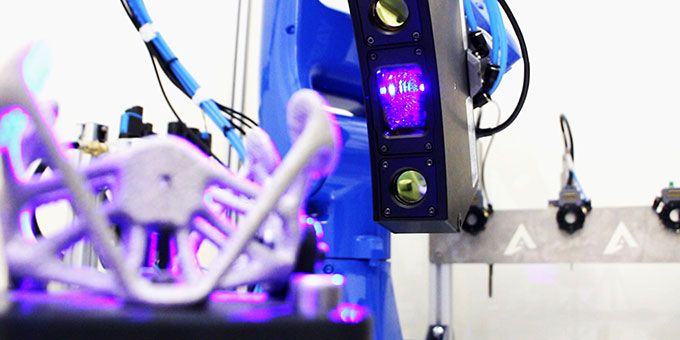The article will show how a 'local for local' production model - the strategy of manufacturing goods in proximity to their intended customers to promote regional self-sufficiency - can become a reality thanks to digital manufacturing.
 The Rise of the Robots — So What?
The Rise of the Robots — So What?

David Alatorre, Chief Technical Officer, | Rivelin Robotics
This article aims to explore the challenges being faced by manufacturing organisations across industries. A societal and cultural shift away from manual, craftsmanship-based roles, coupled with the perception of health risks in manufacturing occupations has led to a significant skills shortage in the sector. Various other challenges include regulatory pressures, unstable supply chains, and unprecedented uncertainties — all of which are exacerbating the situation and threatening the competitiveness of manufacturing enterprises. However, this article posits that the solution to these escalating issues lies within the realm of digitalisation and automation technology.

Our analysis is rooted in the evolution of job market trends, and the opportunities presented by innovations such as Rivelin NetShape®, a frontrunner in the digital revolution of manufacturing. By harnessing machine learning, advanced sensors, and proprietary algorithms, this technology transforms skilled manual tasks for post processing and finishing metal parts and components into repeatable, traceable digital procedures that significantly boost productivity and reduce costs.
The article will go on to present a future where the burdens of manual labour can be alleviated by robotics and AI, and show how a 'local for local' production model - the strategy of manufacturing goods in proximity to their intended customers to promote regional self-sufficiency - can become a reality thanks to digital manufacturing. Furthermore, we posit that these changes in the industry make roles like 'Digital Manufacturing Engineer' increasingly appealing to a new generation of computer-literate, technically-minded job-seekers. The objective of this communication is to assess the impending shift from manual craftsmanship to digital procedures, and from low-cost overseas production to local digital manufacturing; offering insights for industry stakeholders and business leaders navigating these changes.
DIGITAL MANUFACTURING AND THE LABOUR MARKET
Despite recent advancements in industrial safety standards and protocols, manufacturing occupations are still associated with a multitude of health risks such as exposure to harmful substances, repetitive strain injuries, hand-arm vibration syndrome, dust inhalation, hearing loss, vision deterioration, and risks related to machinery accidents, fire, and electrical hazards. It is hypothetically possible to eliminate these risks through comprehensive safety measures; but, even then, trends suggest that this alone will not prevent the looming skills shortage.
Over recent years, the allure of traditional skilled workforce sectors such as manufacturing has been diminishing. As pointed out by Muro et al. in their research at Brookings Institution, societal progression and technological development have catalysed an evolution in the job market, shifting the focus from manual, craftsmanship-based roles to those centred on digital skills and intellectual stimulation.
One of the key factors contributing to this shift is the rapid advancement of technology and digitalisation across various industries. The digital revolution has created new and exciting opportunities in fields like artificial intelligence (AI), data science, software development, robotics and automation. These professions are attractive as they involve working with cutting-edge, innovative technologies to solve complex problems, and push through new boundaries. Organisations of all sizes increasingly rely on digital technologies to enhance their operations, improve efficiency, and gain a competitive edge.
Safety considerations are also a significant factor in career choices, along with physical exertion. As a result, traditional industries like manufacturing and construction are typically associated with being physically demanding and higher risk. For younger people entering the workforce, manufacturing jobs are less likely to attract them for the above reasons. This is supported by a survey conducted by Deloitte, which found that millennials and Gen Z workers prioritise purpose and meaning in their careers and avoid higher risk industries.
As a consequence, across the global workforce, but particularly in Western cultures, millions of physical and skilled positions remain unfilled, not necessarily due to salary constraints or flawed policies but because of a pronounced shift towards more fulfilling and safe professions.
RE-INDUSTRIALISATION OF WESTERN ECONOMIES
This skills shortage is only one among a growing list of factors escalating manufacturing costs. The manufacturing sector is grappling with a multitude of other challenges such as unstable supply chains shaken by global events, regulatory pressures tightening the requirements for quality and traceability, and unprecedented uncertainties. The combination of these factors leads to spiralling costs, threatening the competitiveness of manufacturing enterprises.
Here we will expand further on these challenges and their implications:
Supply Chain Susceptibility to Shocks: More than any event in recent history, the COVID-19 global pandemic crystallised how vulnerable global supply chains actually are. During the height of the pandemic years almost one third (30%) of UK manufacturing companies struggled with disruptions across their supply chains and sourcing essential goods and components. Almost every industrial manufacturer (97%) reported some form of negative effect. Western economies found themselves heavily reliant on distant suppliers who were also in chaos due to lock-downs, workers in isolation and reduced transportation / shipping capacity. This has led directly to companies looking to reduce supply chain risks by reshoring certain industries in the west. Moreover, in the UK in particular, Brexit has also contributed to further supply chain disruption, with 1 in 10 manufacturers reporting Brexit-related supply chain disruptions due to added bureaucracy for goods crossing borders and increased costs. Furthermore, extraordinary events such as the blockage of the Suez Canal in March 2021 also demonstrate the potential fragility of global trade routes. Individually and together, these events serve as indicators for manufacturing companies to diversify – and shorten — their supply chains, promote national and regional production, and mitigate the risks associated with relying on a single transportation route or region.
Geopolitical Factors: Geopolitical tensions are nothing new and neither is their effect on global trade. The world is currently grappling with the fallout from conflict in Ukraine following the Russian invasion, which has had a considerable impact on the economic landscape, particularly in terms of energy supply (with average prices of non-household electricity up 131% and gas 215% in the European Union over the conflict period) and manufacturing. Western economies, seeking to reduce dependency on foreign powers for such critical resources and industries may prioritise re-industrialisation efforts to enhance self-sufficiency and reduce vulnerabilities to potential disruptions. As President Biden put it at the recent G7 summit in Hiroshima, countries should “push to build a more resilient and inclusive global economy that can better withstand the kinds of shocks that we’ve experienced over the last few years, including by building a more secure and more diversified supply chain”. Countries are looking at ways to invest in domestic industries to regain economic strength, to maintain a competitive edge, to protect national security and to advance technological leadership.
Government Policy Priorities: A strong industrial base is one way that governments can look to protect resilience against potential risks. This can include prioritising policies that support the revitalisation of key industries, such as defence, energy, telecommunications, and critical infrastructure. This can also bring the benefits of stimulating job creation and economic growth by supporting domestic production and innovation. The recent signing into law of the CHIPS and Science Act of 2022 in the United States is one example of targeted reshoring policy, and the President’s statements in Hiroshima about “protecting a narrow set of advanced technologies critical for national security” further reinforces this pattern. The European Union is also showing interest in sector-specific policies to promote reshoring, both indirectly - such as through carbon taxes and public procurement rules - and directly - such as through stockpiling mandates and trade/tariff policy. As more governments experiment with sector-specific reshoring initiatives, consensus will gradually form on how to effectively drive reindustrialisation.
Some potential solutions to these challenges lie in the technological advancements of the last decade, particularly in automation technology. The convergence of advanced software tools, artificial intelligence and robotics offers a promising path towards re-industrialisation. As the experienced workforce edges towards retirement and the global west steers away from inexpensive foreign labour, manufacturing enterprises are turning to the digital paradigm; a world where humans shape ideas, and technology crafts them into reality.
LOOKING TO THE FUTURE
One such technology set leading the digital revolution in the manufacturing sector is Rivelin NetShape®, focused on metal near-net-shape manufacturing. Utilising machine learning, advanced sensors, and proprietary algorithms, Rivelin’s software engineers strive to encapsulate craftsmanship and intuition with the repeatability and traceability that industrial robotics provide. NetShape® transforms skilled manual tasks into digital procedures that can be executed repeatedly, with minimal oversight, to produce high quality, finished metal parts. Rivelin’s robots have already made significant strides in the casting and metal additive manufacturing sector, considerably boosting productivity and efficiency, reducing costs and eliminating high risk working conditions.
Rivelin’s focus is on delivering a sustainable manufacturing future for businesses, their people and the planet. Digital innovation and progress is not a threat to manual jobs in manufacturing, it offers a new paradigm, one focused on humans shaping ideas and technology crafting them — safely, efficiently and sustainably.
Rivelin NetShape® and automation platforms like it will be instrumental in unlocking sustainable ‘local-for-local’ production around the world. This paradigm involves creating localised digital production ecosystems powered by automation technology where products are manufactured near the locations where they will be consumed. Advanced manufacturing technologies enable this shift for industries like aerospace, defence, energy and medical, where part complexity, small batch sizes and skills requirements drove manufacturing overseas to begin with. By focusing on local production, companies can increase efficiency, responsiveness and resilience while cutting costs, reducing emissions and supporting regional economies.
CONCLUSION
There are critical issues plaguing the manufacturing sector, ranging from a significant skills shortage to unstable supply chains, regulatory pressures and unprecedented uncertainties. The situation necessitates urgent innovative solutions to maintain the competitiveness of manufacturing enterprises. Automation and digital manufacturing technologies such as Rivelin NetShape® can help address these issues. By capitalising on machine learning, advanced sensors, and proprietary algorithms, these digital platforms transform skilled manual tasks into repeatable, efficient, and safer digital procedures. This not only boosts productivity and reduces costs but also makes the manufacturing sector more appealing to a digitally oriented, safety-conscious workforce.
The unfolding digital revolution in manufacturing is painting a future where robotics and AI can significantly alleviate the demands of manual labour. It enables the transition to a 'local for local' production model, where goods are manufactured close to their intended customers, promoting regional self-sufficiency and reducing supply chain vulnerabilities. The digitalisation of the manufacturing industry has profound implications, particularly in reindustrialising western economies, enhancing resilience, and diversifying supply chains.
In conclusion, as societal, technological, and economic dynamics continue to evolve, embracing digitalisation and automation technology in manufacturing emerges as an effective strategy to navigate and mitigate the challenges confronting the sector. It lays a sustainable foundation for the industry, marrying human creativity with technological precision to ensure a safer, efficient, and productive future for manufacturing. The journey from manual craftsmanship to digital procedures is not merely a transition but a transformation offering immense possibilities for businesses, workforce, and economies at large.
REFERENCES
- Muro et al.
- Muro et al. 2
- Deloitte
- 4IR
- ONS
- Ernst Young
- Eurostat
- White House
- EU Parliament
- G7 transcript
The content & opinions in this article are the author’s and do not necessarily represent the views of ManufacturingTomorrow
Comments (0)
This post does not have any comments. Be the first to leave a comment below.
Featured Product

